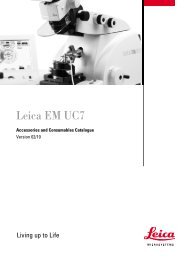Physical Principles of Electron Microscopy: An Introduction to TEM ...
Physical Principles of Electron Microscopy: An Introduction to TEM ...
Physical Principles of Electron Microscopy: An Introduction to TEM ...
Create successful ePaper yourself
Turn your PDF publications into a flip-book with our unique Google optimized e-Paper software.
138 Chapter 5<br />
Backscattered electrons can be detected by a scintilla<strong>to</strong>r/PMT detec<strong>to</strong>r if<br />
the bias on the first grid is made negative, <strong>to</strong> repel secondary electrons. The<br />
BSEs are recorded if they impinge directly on the scintilla<strong>to</strong>r (causing light<br />
emission) or if they strike a surface beyond the grid and create secondaries<br />
that are then accelerated <strong>to</strong> the scintilla<strong>to</strong>r (see Fig. 5-8). The BSEs travel in<br />
almost a straight line, their high energy making them relatively unresponsive<br />
<strong>to</strong> electrostatic fields. Consequently, more <strong>of</strong> them reach the side-mounted<br />
detec<strong>to</strong>r if they are emitted from a surface inclined <strong>to</strong>ward it, giving some<br />
<strong>to</strong>pographical contrast; as in Fig. 5-7b. However, backscattered electrons are<br />
emitted over a broad angular range, and only those emitted within a small<br />
solid angle (defined by the collec<strong>to</strong>r diameter) reach the scintilla<strong>to</strong>r. The<br />
resulting signal is weak and provides a noisy image, so a more efficient form<br />
<strong>of</strong> detec<strong>to</strong>r is desirable.<br />
In the so-called Robinson detec<strong>to</strong>r, an annular (ring-shaped) scintilla<strong>to</strong>r<br />
is mounted immediately below the objective lens and just above the<br />
specimen; see Fig. 5-11a. The scintilla<strong>to</strong>r subtends a large solid angle and<br />
collects a substantial fraction <strong>of</strong> the backscattered electrons. Light is<br />
channeled (by internal reflection) through a light pipe and in<strong>to</strong> a PMT, as in<br />
the case <strong>of</strong> the Everhart-Thornley detec<strong>to</strong>r.<br />
<strong>An</strong> alternative backscattered-electron detec<strong>to</strong>r is shown in Fig. 5-11b.<br />
This solid-state detec<strong>to</strong>r consists <strong>of</strong> a large area (several cm 2 ) silicon diode,<br />
(a)<br />
scintilla<strong>to</strong>r<br />
specimen<br />
specimen<br />
objective<br />
primary beam<br />
light pipe<br />
(b) objective<br />
primary beam<br />
metal<br />
HV<br />
contacts signal<br />
p-n transition region<br />
light<br />
<strong>to</strong> PMT<br />
Figure 5-11. Backscattered-electron detec<strong>to</strong>rs installed below the objective lens <strong>of</strong> an SEM:<br />
(a) annular-scintilla<strong>to</strong>r/PMT (Robinson) design and (b) solid-state (semiconduc<strong>to</strong>r) detec<strong>to</strong>r.



